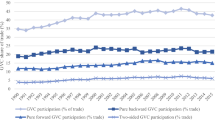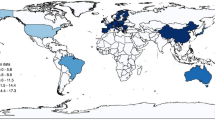Abstract
This chapter reports on the results of an application with the interregional input–output matrix for Colombia. For each flow originating in one of the Colombian departments, the authors estimate measures of the trade in value added. The measures of trade in value-added reveal different hierarchies of interregional and international trade integration, with implications for regional inequality in the country. The parsimonious approach based on “hypothetical extraction” serves as the methodological anchor for the study. The chapter argues that policymakers should consider interregional interactions for a better understanding of how the regional economies are affected, both in the international and domestic markets, since for the smaller economies, the performance of the more developed regions may play a crucial role.
Access this chapter
Tax calculation will be finalised at checkout
Purchases are for personal use only
Similar content being viewed by others
Notes
- 1.
- 2.
On the “Colombian Ostrich”, please see Haddad et al. (2009).
- 3.
The “subpartida arancelaria” is the import and export classification system used in the DIMPE at a basic 10-digit level. It is used to identify products/commodities.
- 4.
Nomenclatura das classificações DANE in: https://www.dane.gov.co/index.php/sistema-estadistico-nacional-sen/normas-y-estandares/nomenclaturas-y-clasificaciones.
- 5.
- 6.
Duranton (2016) explores agglomeration benefits in Colombian cities.
- 7.
Duranton (2015) provides insight into how transport infrastructure affects trade and the organization of economic activity. The author shows that road distance between cities is a significant impediment to domestic trade in Colombia.
References
BACI. (2019). International trade database at the product-level. CEPII. Homepage: http://www.cepii.fr/CEPII/en/bdd_modele/presentation.asp?id=37
Caliendo, L., Parro, F., Rossi-Hansberg, E., & Sarte, P. D. (2018). The impact of regional and sectoral productivity changes on the US economy. The Review of Economic Studies, 85(4), 2042–2096.
DIMPE. (2019). Dirección de Metodología y Producción Estadística. Colombia, Estadísticas de Exportaciones–EXPO–2011–2019. Departamento Administrativo Nacional de Estadística (DANE). Archivo Nacional de Datos (ANDA). Homepage: http://microdatos.dane.gov.co/index.php/catalog/472/get_microdata
Duranton, G. (2015). Roads and trade in Colombia. Economics of Transportation, 4(1), 16–36.
Duranton, G. (2016). Agglomeration effects in Colombia. Journal of Regional Science, 56(2), 210–238.
Galvis, L. A., & Meisel, A. (2013). Regional inequalities and regional policies in Colombia: The experience of the last two decades. In J. R. Cuadrado-Roura & P. Aroca (Eds.), Regional problems and policies in Latin America. Springer.
Haddad, E. A., Bonet, J., Hewings, G. J., & Perobelli, F. S. (2009). Spatial aspects of trade liberalization in Colombia: A general equilibrium approach. Papers in Regional Science, 88(4), 699–732.
Haddad, E. A., Domingues, E. P., & Perobelli, F. S. (2002). Regional effects of economic integration: The case of Brazil. Journal of Policy Modeling, 24(5), 453–482.
Haddad, E. A., Mengoub, F. E., & Vale, V. A. (2020). Water content in trade: A regional analysis for Morocco. Economic Systems Research, 32(4), 565–584.
Haddad, E. A., Perobelli, F. S., Araújo, I. F., & Dentinho, T. P. (2021). Uneven integration: The case of Angola. Revista Portuguesa de Estudos Regionais, 1–32.
Haddad, E. A., & Araujo, I. F. (2020). The internal geography of services value-added in exports: A Latin America perspective. Papers in Regional Science, 1–32.
Haddad, E. A., & Hewings, G. J. D. (2005). Market imperfections in a spatial economy: Some experimental results. The Quarterly Review of Economics and Finance, 45, 476–496.
Haddad, E. A., & Hewings, G. J. D. (2009). Handling market imperfections in a spatial economy: Some experimental results II. Ensayos Sobre Política Económica, 27, 140–193.
Johnson, R. C., & Noguera, G. (2012). Accounting for intermediates: Production sharing and trade in value added. Journal of International Economics, 86(2), 224–236.
Los, B., Timmer, M., & de Vries, G. (2016). Tracing value-added and double counting in gross exports: Comment. American Economic Review, 106(4), 1958–1966.
McCann, P. (2007). Technology, information and the geography of global and regional trade. In R. Cooper, K. Donaghy, & G. Hewings (Eds.), Globalization and regional economic modeling (pp. 15–34). Springer.
Melo-Becerra, L. A., Galvis, L. M. P., Ramos, J., & Solano, H. M. Z. (2020). Effects of booms and oil crisis on Colombian economy: A time-varying vector autoregressive approach. Revista De Economía Del Rosario, 23(1), 31–63.
Munroe, D. K., Hewings, G. J., & Guo, D. (2007). The role of intraindustry trade in interregional trade in the midwest of the US. In R. Cooper, K. Donaghy, & G. Hewings (Eds.), Globalization and regional economic modeling (pp. 87–105). Springer.
OECD. Organization for economic co-operation and development. Trade in value added. OECD statistics on trade in value added (database). Homepage: https://doi.org/10.1787/data-00648-en
Perobelli, F. S., Haddad, E. A., Moron, J. B., & Hewings, G. J. D. (2010). Structural Interdependence among Colombian departments. Economic Systems Research, 22(3), 279–300.
Sonis, M., Hewings, G. J., & Okuyama, Y. (2002). Vertical specialization and interregional trade: Hierarchy of spatial production cycles and feedback loop analysis in the midwest economy. In G. J. Hewings, M. Sonis, & D. Boyce (Eds.), Trade, networks and hierarchies: Modeling regional and interregional economies (pp. 347–364). Springer.
Venables, A. J. (2019). Economic geography and trade. Oxford Research Encyclopedia of Economics and Finance, 1–19.
Author information
Authors and Affiliations
Corresponding author
Editor information
Editors and Affiliations
Rights and permissions
Copyright information
© 2023 The Author(s), under exclusive license to Springer Nature Switzerland AG
About this chapter
Cite this chapter
Pacheco, R., Fernandes, R.P., Araújo, I.F., Haddad, E.A. (2023). Trade in Value-Added: Does MFN Status Matter for Colombian Regions?. In: Haddad, E.A., Bonet, J., Hewings, G.J.D. (eds) The Colombian Economy and Its Regional Structural Challenges. Advances in Spatial Science. Springer, Cham. https://doi.org/10.1007/978-3-031-22653-3_9
Download citation
DOI: https://doi.org/10.1007/978-3-031-22653-3_9
Published:
Publisher Name: Springer, Cham
Print ISBN: 978-3-031-22652-6
Online ISBN: 978-3-031-22653-3
eBook Packages: Economics and FinanceEconomics and Finance (R0)




